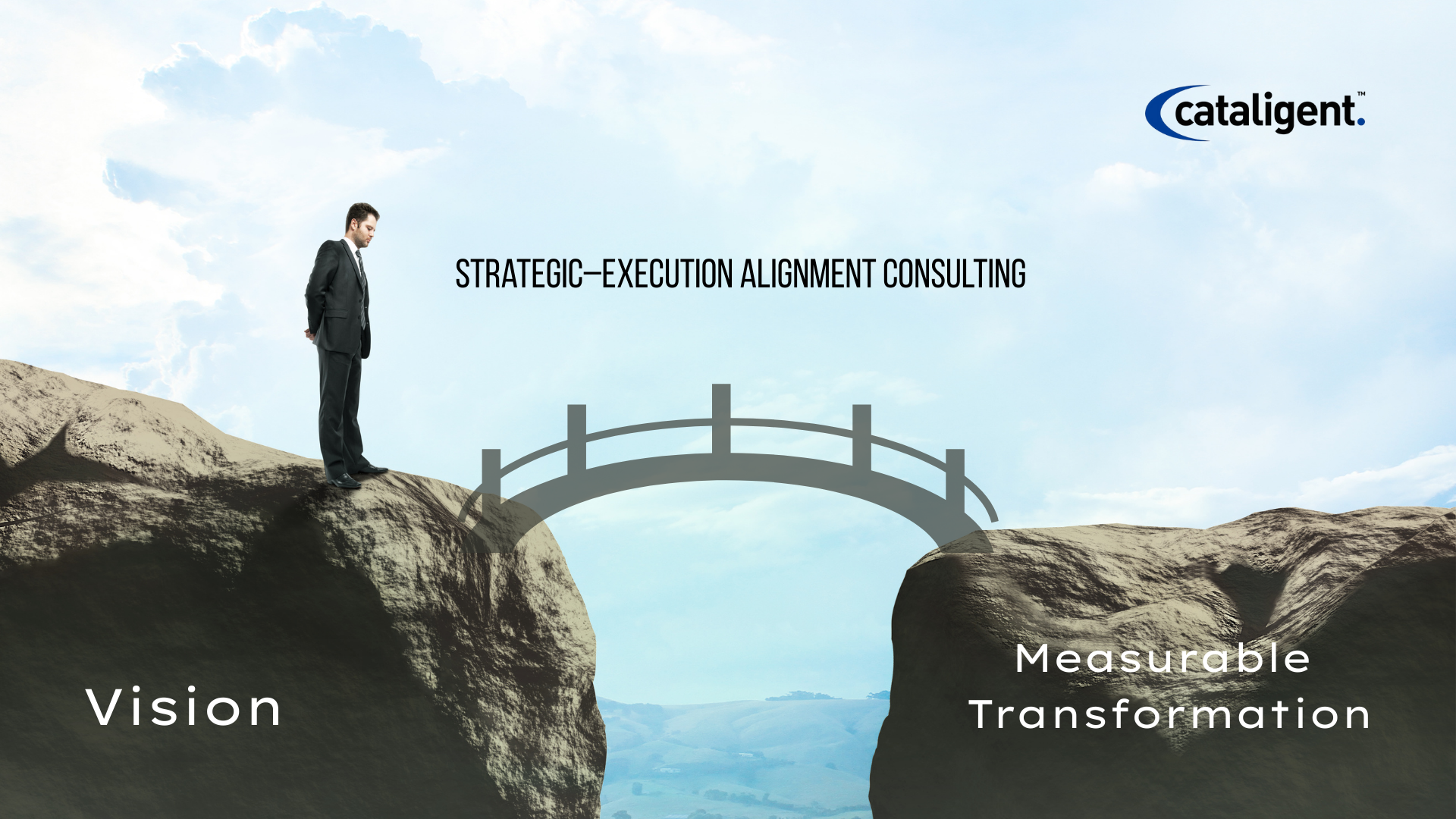Many organizations excel at setting bold strategies. Vision statements, roadmaps, and board-level ambitions often point toward transformation that is ambitious, forward-thinking, and competitive. Yet, when these strategies travel downstream into execution, they often lose momentum, clarity, and alignment. The result? Strategic initiatives that look inspiring on paper but fail to materialize into measurable transformation outcomes.
Strategic–execution alignment consulting addresses this persistent gap. It ensures that strategy doesn’t remain aspirational but becomes operational—translated into initiatives, metrics, and outcomes that drive genuine business transformation.
What It Is
Strategic–execution alignment consulting focuses on designing frameworks, operating models, and governance mechanisms that directly connect top-level vision with day-to-day execution. It ensures:
- Clear Line of Sight: Every project and initiative can be traced back to a strategic objective.
- Measurable Outcomes: Success is defined not just in activity but in results—whether customer growth, cost optimization, or operational agility.
- Execution Discipline: Processes, teams, and accountability structures ensure strategy doesn’t dissolve into disconnected projects.
- Continuous Realignment: Feedback loops allow organizations to adapt as markets, technologies, or priorities evolve.
Why It Matters
1. Bridging the Strategy–Execution Divide
Research consistently shows that most organizations fail to realize the majority of their strategic goals. Without consulting that bridges the divide, transformation becomes a cycle of unfulfilled ambition.
2. Unlocking Transformation ROI
A well-articulated strategy without execution alignment leads to wasted resources. By directly linking vision to measurable initiatives, organizations ensure transformation investments yield tangible ROI.
3. Reducing Fragmentation
Without alignment, departments and teams often pursue disconnected priorities. Consulting ensures initiatives are interlinked, preventing duplication and aligning resources toward enterprise-level outcomes.
4. Accelerating Decision-Making
When strategy is connected to execution, leaders have clearer visibility into what’s working, what’s lagging, and where adjustments are needed. This accelerates decision-making and keeps transformation on track.
5. Building Organizational Confidence
Employees often feel disconnected from high-level strategies. Clear alignment ensures teams see how their work contributes to transformation, fostering engagement, ownership, and motivation.
How to Address It
1. Strategy Decomposition
Break down high-level strategies into measurable objectives and actionable initiatives. Frameworks like OKRs (Objectives and Key Results) ensure every activity ties back to a larger goal.
Example: A vision of “customer-centric growth” is decomposed into measurable KPIs such as Net Promoter Score improvements, digital adoption rates, or reduced churn.
2. Governance Structures
Establish governance forums that review not just projects but their alignment to strategy. This ensures that projects don’t drift into siloed execution without contributing to transformation goals.
Example: A governance board reviews whether a digital upgrade initiative directly supports strategic objectives like operational agility or customer satisfaction.
3. Portfolio Management Discipline
Move from managing individual projects to managing transformation as a portfolio. Portfolio management ensures resources, budgets, and timelines are allocated where they drive maximum strategic value.
4. Feedback Loops & Realignment
Embed mechanisms for continuous feedback—surveys, data dashboards, and performance reviews—to realign execution with strategy as external conditions shift.
Example: If regulatory changes impact compliance initiatives, realignment ensures transformation timelines are adjusted without losing sight of long-term strategy.
5. Accountability & Leadership Alignment
Executives and managers must model alignment, holding themselves accountable for both strategic clarity and operational discipline. Consulting helps define clear ownership for every level of execution.
How Cataligent Helps
Cataligent specializes in ensuring strategies don’t end as presentations but become transformation realities:
- Strategy-to-Execution Frameworks: Proven methodologies that translate vision into measurable initiatives, KPIs, and deliverables.
- Portfolio & Governance Models: Tools that manage transformation holistically, avoiding duplication and ensuring alignment.
- Outcome-Based Metrics: Dashboards that measure results, not just activities, to track transformation ROI.
- Adaptive Realignment Processes: Mechanisms that allow strategy and execution to stay in sync despite market volatility.
- Leadership Coaching: Empowering leaders to bridge strategy and execution through clarity, accountability, and visible ownership.
Closing Thought
Transformation ambitions collapse when strategy and execution live in separate worlds. Consulting that unites them creates not only clarity but also measurable outcomes that prove the value of transformation. Strategic–execution alignment turns vision into momentum, ambition into progress, and plans into results.
Cataligent enables organizations to close this divide. By embedding frameworks, governance, and continuous feedback, it ensures transformation is not just envisioned—it is delivered, sustained, and scaled.

